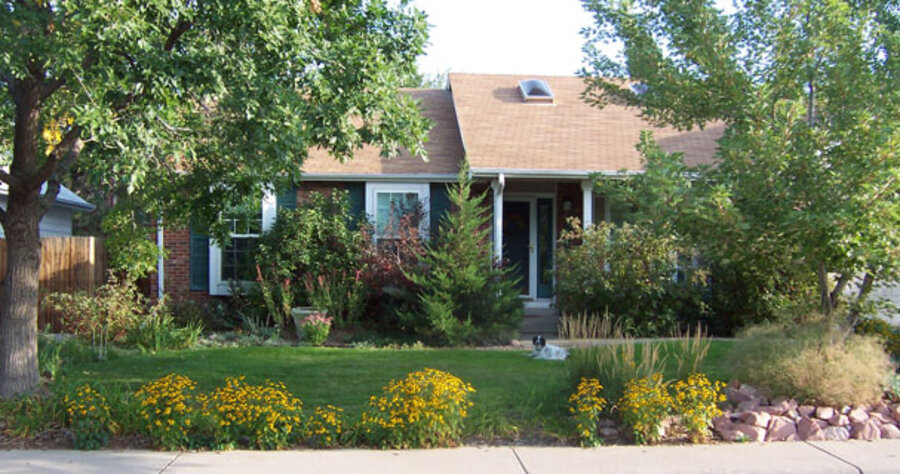Xeriscaping: good for nature – and gardeners
Loading...
I'd been house hunting for months when the realtor stopped in front of a little ranch-style house, and I instantly knew I was home. This one definitely spoke to me. The house was shaded by a large ash tree on one side of the yard and a small maple on the other. The lawn was lush and emerald green.
But in my excitement I failed to notice that the yard had no sprinkler system. I might as well confess: I'm a lazy gardener. I had no idea of the amount of hose-dragging I would need to do to keep that lawn green.
I live in Colorado. Despite substantial snowfalls in the mountains each winter, the state's average annual precipitation is only 17 inches. That means we almost qualify as a desert.
Still, with average precipitation and a little irrigation, our lawns can be just as thick as any to the east, where rainfall is more abundant. Whether it's a good idea is another story. But at that point, it's what I wanted.
The summer after I bought the house, there was less precipitation than the year before. I found myself spending too much time dragging the hose around the yard. I also found that it was difficult to water the corners without watering the sidewalk. So my beautiful turf began to turn a little brown around the edges.
The next year was even drier, and I had a nagging feeling my hose-dragging days were numbered. Surely it was only a matter of time before mandatory watering restrictions would be imposed.
The idea of taking care of a lawn during a drought spurred me to action. I would transform that thirsty, sunburned landscape into one that used less water – and required a lot less work. I had read about xeriscaping (ZEER-uh-scaping), a landscaping technique that conserves water by reducing the amount of irrigated turf and adding drought-tolerant native plants.
Armed with a plan, a can of orange spray paint, and a shovel, I dug in. Following the orange, peanut-shaped outline I had painted on the lawn, I dug up large chunks of my once-lovely sod.
Shovelful by shovelful, I removed the grass, piled it into an old red wheelbarrow, and wobbled it across the street to a neighbor's house. As quickly as I was digging the grass up from my yard, he was laying it down in his. I was delighted. Every piece of turf delivered to my neighbor meant less lawn for me to water, weed, rake, fertilize, and mow.
Every weekend that May. I'd pull on my worn leather work gloves early on Saturday and dig until the sun made it too hot to continue.
I worked in phases. Phase one, dig up a large section of grass. Phase two, plant water-wise native flowers and shrubs. Phase three, spread mulch on top of the soil around the new plants to conserve any moisture in the ground. Then I'd move on to the next section.
I grouped colorful, low-care perennials according to their water needs – from moderate to xeric. This method, called hydrozoning, makes watering more efficient. Plants that need the most water were placed nearest the irrigated turf area; xeric plants were placed farther away.
Downspouts were positioned to flow directly into the garden. A transition zone of hardy plants was created between the grass and the sidewalk to capture the water before it could run off.
It was backbreaking work, and I'll admit that it occurred to me that moving a hose from place to place around the yard wasn't that strenuous after all.
Often neighbors would drop by to chat about what I was doing. While kneeling in the dirt, calculating the distance between planting holes for the Western sand cherry shrubs, for example, I had to stop and answer questions.
"Are you putting in a sprinkler system?" they asked.
"No," I replied. "I'm xeriscaping."
"What does that mean?" they asked.
"It means a lot less work for me," I replied.
"Well, what you're doing looks like a lot more work," they said.
Some people think a xeriscape must resemble Death Valley – bone-dry and filled with cacti. But it doesn't have to be that way. It can look as refreshing as any oasis. My small area of grass gives the illusion of a lawn, but its size means less watering for me – and a big boost for the environment.
The next summer was one of the driest on record in my area, and lawn irrigation was indeed rationed. By then my xeriscape was well-rooted. While other yards turned brown, my hard work paid off in bunches of blossoms.
Besides being a more colorful landscape, my yard now takes less time to maintain and uses about half the water as before. It feels good to know I did my part to give Mother Nature a hand.
The fact is, there will always be a drought somewhere in Colorado, and it doesn't make sense for residents to keep irrigating large swaths of Kentucky bluegrass.
I've now become fanatical about saving water in my landscape, but being a lazy gardener will always be my first priority.





